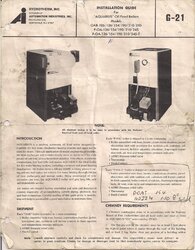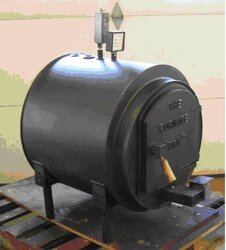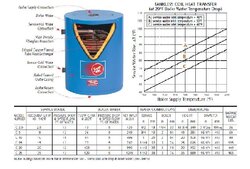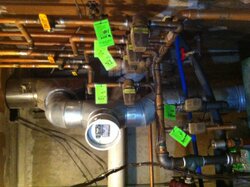couldnt find much info searching. how much heat is actually lost up the oil boiler flu pipe? my setup is run in series. hot water comes from storage, through zones, then through oil boiler and back to storage via close-t regulated by set-point circ. the water going through oil boiler is only 140*f and i think i will try backing this off to 120*. wondering if it is worth it to install an electric damper in oil boiler flu that will open when the oil burner kicks on? this will only happen if/when stoarge temps get too low. the thought is to keep the oil boiler from losing too much between calls for heat. i know that paralell may have been better but install would have been a bit more complicated with plumbing/valves and automated controls. and is it better to have water circulating through oil boiler anyway? thoughts?
heat loss through oil boiler flu
- Thread starter Coal Reaper
- Start date
-
Active since 1995, Hearth.com is THE place on the internet for free information and advice about wood stoves, pellet stoves and other energy saving equipment.
We strive to provide opinions, articles, discussions and history related to Hearth Products and in a more general sense, energy issues.
We promote the EFFICIENT, RESPONSIBLE, CLEAN and SAFE use of all fuels, whether renewable or fossil.
You are using an out of date browser. It may not display this or other websites correctly.
You should upgrade or use an alternative browser.
You should upgrade or use an alternative browser.
- Status
- Not open for further replies.
avc8130
Minister of Fire
couldnt find much info searching. how much heat is actually lost up the oil boiler flu pipe? my setup is run in series. hot water comes from storage, through zones, then through oil boiler and back to storage via close-t regulated by set-point circ. the water going through oil boiler is only 140*f and i think i will try backing this off to 120*. wondering if it is worth it to install an electric damper in oil boiler flu that will open when the oil burner kicks on? this will only happen if/when stoarge temps get too low. the thought is to keep the oil boiler from losing too much between calls for heat. i know that paralell may have been better but install would have been a bit more complicated with plumbing/valves and automated controls. and is it better to have water circulating through oil boiler anyway? thoughts?
What type of burner is on your oil boiler?
ac
type? beckett i believe. whats that matter? might there be a way to shut the air off going into the unit? i need something that i dont have to go down there and manually reposition tho.
Nofossil
Moderator Emeritus
The problem is that natural draft will pull a surprising amount of cool basement air through a hot boiler and up the chimney. That basement air is replaced by outdoor air that has to infiltrate from somewhere.
Reducing this loss is one of the reasons for plumbing wood and oil boilers in parallel rather than in series - cool boilers don't lose as much heat this way.
Years ago I heard of motorized dampers to close the oil boiler flue. You'd need an interlock so that the boiler couldn't fire if the damper weren't open, and it seems like one more thing to fail. Don't know if they still exist and/or if they meet code.
There's been a LOT of learning in the last few years about making the building envelope airtight. I'll bet that someone has a good solution.
Reducing this loss is one of the reasons for plumbing wood and oil boilers in parallel rather than in series - cool boilers don't lose as much heat this way.
Years ago I heard of motorized dampers to close the oil boiler flue. You'd need an interlock so that the boiler couldn't fire if the damper weren't open, and it seems like one more thing to fail. Don't know if they still exist and/or if they meet code.
There's been a LOT of learning in the last few years about making the building envelope airtight. I'll bet that someone has a good solution.
hobbyheater
Minister of Fire
couldnt find much info searching. how much heat is actually lost up the oil boiler flu pipe? my setup is run in series. hot water comes from storage, through zones, then through oil boiler and back to storage via close-t regulated by set-point circ. the water going through oil boiler is only 140*f and i think i will try backing this off to 120*. wondering if it is worth it to install an electric damper in oil boiler flu that will open when the oil burner kicks on? this will only happen if/when stoarge temps get too low. the thought is to keep the oil boiler from losing too much between calls for heat. i know that paralell may have been better but install would have been a bit more complicated with plumbing/valves and automated controls. and is it better to have water circulating through oil boiler anyway? thoughts?
Actual heat loss for me with my original wood and oil plumbed in series amounted to 4 1/2 cords per year.
Years later when storage was added and the oil boiler heated storage and standby loss was eliminated, its oil consumption was cut by 60%
Stack loss can be huge!
understood. my oil boiler was brand new right before i bought the house and i would have done a parallel setup if it wasnt so convieniently easy to go series with just the close-t fitting and not mess with the rest of the plumbing.The problem is that natural draft will pull a surprising amount of cool basement air through a hot boiler and up the chimney. That basement air is replaced by outdoor air that has to infiltrate from somewhere.
Reducing this loss is one of the reasons for plumbing wood and oil boilers in parallel rather than in series - cool boilers don't lose as much heat this way.
Years ago I heard of motorized dampers to close the oil boiler flue. You'd need an interlock so that the boiler couldn't fire if the damper weren't open, and it seems like one more thing to fail. Don't know if they still exist and/or if they meet code.
There's been a LOT of learning in the last few years about making the building envelope airtight. I'll bet that someone has a good solution.
i have sourced electronic dampers from $100-150. still researching but i think one model will not let the boiler fire unless the damper is open and the other one has an over temp cutout if it doesnt open. yes, another thing to potentially fail, but functional operation is simple.
allan, are you saying that was consumption was reduced by 4.5 cords by just switching from series to parallel?
avc8130
Minister of Fire
What oil burner do you have?
Some oil burners have shutters that cover the air intake when the burner isn't firing (Riello comes to mind).
ac
Some oil burners have shutters that cover the air intake when the burner isn't firing (Riello comes to mind).
ac
JP11
Minister of Fire
I used close spaced T's on the out (hot) leg of the oil boiler. I get surprisingly little heat into the oil boiler jacket on almost all ops. The only thing that seems to heat it up is when the indirect DHW tank calls.. that pump is really big and seems to push some heat into the oil boiler.
JP
JP
velvetfoot
Minister of Fire
yes, that is what i am looking at. need to see when i get home if i even have room to put it in.I have this. Seems to work fine.
http://www.fieldcontrols.com/ovd.php
velvetfoot
Minister of Fire
maple1
Minister of Fire
I'm pretty sure my Riello burner had an air intake shutter on it - it opened when the burner cut in & closed when it cut out. Should help a lot with stack losses.
Wonder if it's worth it to swap in a Riello? They're real nice burners, as far as burning oil goes. Might be able to find a nice used one.
Wonder if it's worth it to swap in a Riello? They're real nice burners, as far as burning oil goes. Might be able to find a nice used one.
Thanks. Think its worth the $150?
avc8130
Minister of Fire
I may just have to try that. Any issues with code or anything having it down there or so close to boiler?
velvetfoot
Minister of Fire
I think it has to be downstream of the barometric damper.
manual: http://www.fieldcontrols.com/pdfs/46567100OVDInstSheetRevA0109.pdf
manual: http://www.fieldcontrols.com/pdfs/46567100OVDInstSheetRevA0109.pdf
Yeah i meant putting electric damper where the barometric one currently is and moving barometric down closer to boiler.
hobbyheater
Minister of Fire
are you saying that was consumption was reduced by 4.5 cords by just switching from series to parallel?

The oil boiler was the one pictured on the left. The boiler had a 6" flue connection. There was an asbestos lined fire box on top which sat three cast iron sections of water tubes which made its heat exchanger. These sections weighed just under 300 lbs and held a total of 3 1/2 gallons of water. There was also a tankless coil for domestic hot water. The boiler's primary function was to produce DHW with house heat being secondary so it maintained a water temperature of 170 F to 185 F for domestic supply with the circulator running continuously to ensure a constant flow of hot water through the coil.
Years later with storage and the Jetstream in operation and the oil boiler now just a back up, all valves for domestic supply and house heat were closed to the oil boiler and an hour meter was connected to record the operating time of the oil burner. Over a three day period with no load, the burner ran for 13 hours. This 13 hours represented the stand-by loss, wasted heat going up the chimney. The boiler would run for more than 3 hours day to maintain standby temperature for DHW, so over a week this stand-by loss represented more than 21 hours of operation.
I'm a person who likes to tinker so I connected the oil boiler to the storage. Average operating time of the oil boiler dropped to between 12 to15 hours per week when heating storage.
Connecting your oil boiler to storage is not something that I would recommend for everyone without doing your homework. Our storage is well insulated with a very low heat loss of around 1,200 BTUs per hour for 1,000 gallon tank , plus the oil boiler in this set up was lower than storage. No gravity flow when the boiler was not operating.

The wood boiler pictured is the same as was being used at the time. The instructions in the boiler manual were for a series connection which required the oil boiler circulator to operate continuously to moving the water between oil and wood boilers to ensure a constant flow of hot water through the tankless coil in the oil boiler. The aquastat on the wood boiler was set to maintain a water temperature of 170 F / 185 F. The wood boiler in series with the oil boiler burned 22 cords the first year!
This little wood boiler was pretty much burnt out at the end of the second year. The constant cycling of a hot fire, metal around the flue and draft glowing red hot, then having the draft suddenly close, the steel around the draft control and flue had cracked and had been welded several times.

The second year of operation the boilers were plumbed to operate in parallel, with the smallest tankless coil like the one pictured being used for DHW.
With the wood boiler operating without heating the oil boiler's 300lbs of cast iron, wood consumption dropped to between 17 /18 cords (4'x4'x8') in the second year.
These are some observations that may or may not be of some use to you
Allan
Last edited:
- Status
- Not open for further replies.
Similar threads
- Replies
- 8
- Views
- 606
- Replies
- 0
- Views
- 953
- Replies
- 9
- Views
- 2K
- Replies
- 8
- Views
- 439


